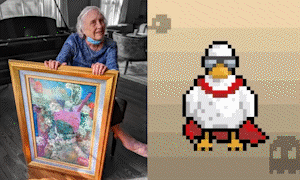
26 Nov Sleeping Princes: Figurative Expressionism in a Digital World
We haven’t had much inspiration from experiencing the external world in 2021; even impressions of that world are often just figments of our Instagram or TikTok-fueled imaginations. The urban melange of the weekend brunch, the Sunday a la park, the Newbury Street promenade – were mostly lost to the pandemic and lockdowns, replaced by house arrest in our ateliers.
In these ateliers, however, we have become more expressive without knowing it, even if this expressionist urge is constrained. If you put most of us in front of a canvas with buckets of paint, we would likely emote the feelings we have experienced inside rather than seek to capture the world outside.
What will this post-COVID canvas express? Abstraction or figuration? Squares or humans? Our endless Zoom calls abstract the human experience into a series of squares on a digital canvas, reminiscent of the Rothkos we have missed seeing. But those squares all contain a pixelated human with whom we have a connection. The pandemic has dulled our interpretation of the human signals that our ancestors spent millennia honing; would the canvas recapture the human experience in a figurative, digital way? I think it would need to: we crave the expression of human connection, of the human face, of the human figure.
In this digital context, we must revisit Figurative Expressionism, a movement connecting the desire for abstraction from the world to the emotive humanness that defines it. I first started wandering down its history upon acquiring Sleeping Prince, a striking ‘magic realism’ piece of the painter Kahlil Gibran – nephew of the eponymous poet. Kahlil was a graduate of Boston’s Museum of Fine Art, an incredibly versatile artist, and a leader of the Boston avant-garde who incubated Figurative Expressionism in America. He would have turned 99 this week; he and his peers left a legacy worth revisiting in this new digital context. I had the honor of spending some time with his widow Jean Gibran, whose insights into the movement, its inspiration, and its impact have helped me gain a different perspective on how human beings feel.
Everywhere we look, we find ourselves craving connection in a new native digital fabric, but it feels lacking in emotional expression and authentic human signal. Beeple’s ‘Everydays – The First 5000 Days’ felt like an effort to claim this canvas, but it fell short of producing anything artistically interesting, let alone a beacon of digital expressionism.
The widespread investment in NFTs is an enabler of the Figurative Expressionist renaissance; many artists seek to express freedom, parity, inclusion through architecture of projects themselves and ultimately through faces and real online identities. The quality of art in the NFT marketplace does not, however, compare to that of the great expressionists of the past. Perhaps the Bored Ape Yacht Club or Chain Runners lean on the idea of a collective creator experience to be expressionist; for me, however, the best art is produced through the emotion of the individual.
The shift is inevitable, however. Who are the Kahlil Gibrans – both the uncle and the nephew – of the metaverse? How will we ultimately express ourselves – in poems or pixels – in a way that is machine-enabled while still being authentically human? I won’t be changing my Twitter profile to some speculative NFT, but I would love to interact with and promote the real digital creators and artists. I’m thankful to all such artists – writers, painters, musicians, dancers, etc – for giving us purpose and expression to appreciate the world within us.


